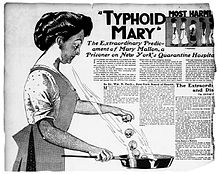
Back عدوى من دون أعراض Arabic Infección subclínica Spanish 不顕性感染 Japanese Latente infectie Dutch Infecção subclínica Portuguese การติดเชื้อไร้อาการ Thai Subklinik enfeksiyon Turkish Nhiễm trùng cận lâm sàng Vietnamese 亞臨床感染 Chinese

A subclinical infection—sometimes called a preinfection or inapparent infection—is an infection by a pathogen that causes few or no signs or symptoms of infection in the host.[1] Subclinical infections can occur in both humans and animals.[2] Depending on the pathogen, which can be a virus or intestinal parasite, the host may be infectious and able to transmit the pathogen without ever developing symptoms;[3][4] such a host is called an asymptomatic carrier.[3] Many pathogens, including HIV, typhoid fever, and coronaviruses such as COVID-19 spread in their host populations through subclinical infection.[3][4][5]
Not all hosts of asymptomatic subclinical infections will become asymptomatic carriers. For example, hosts of Mycobacterium tuberculosis bacteria will only develop active tuberculosis in approximately one-tenth of cases;[6] the majority of those infected by Mtb bacteria have latent tuberculosis, a non-infectious type of tuberculosis that does not produce symptoms in individuals with sufficient immune responses.[7]
Because subclinical infections often occur without eventual overt sign, in some cases their presence is only identified by microbiological culture or DNA techniques such as polymerase chain reaction (PCR) tests.[8][9]
- ^ Porta, Miquel (2014). Oxford dictionary of epidemiology (6th ed.). Oxford: Oxford University Press. ISBN 978-0-19-997672-0.[page needed]
- ^ Dimijian, Gregory G. (January 2000). "Pathogens and Parasites: Strategies and Challenges". Baylor University Medical Center Proceedings. 13 (1): 19–29. doi:10.1080/08998280.2000.11927638. PMC 1312209. PMID 16389321.
- ^ a b c "Principles of Epidemiology | Lesson 1 - Section 9". www.cdc.gov. 2021-12-20. Retrieved 2023-01-26.
- ^ a b Bogoch, Isaac (16 May 2020). "The Term 'Asymptomatic' Is More Complicated Than It Seems When It Comes To Coronavirus Infections". Forbes.
- ^ "Questions and Answers | Typhoid Fever | CDC". www.cdc.gov. 2020-11-16. Archived from the original on 2016-06-08. Retrieved 2023-01-26.
- ^ "Tuberculosis (TB) Detailed Explanation". National Institute of Allergy and Infectious Diseases. 2009-03-06. Archived from the original on 2010-04-11. Retrieved 2023-01-26.
- ^ Drain, Paul K.; Bajema, Kristina L.; Dowdy, David; Dheda, Keertan; Naidoo, Kogieleum; Schumacher, Samuel G.; Ma, Shuyi; Meermeier, Erin; Lewinsohn, David M.; Sherman, David R. (2018-07-18). "Incipient and Subclinical Tuberculosis: a Clinical Review of Early Stages and Progression of Infection". Clinical Microbiology Reviews. 31 (4): e00021–18. doi:10.1128/CMR.00021-18. ISSN 0893-8512. PMC 6148193. PMID 30021818.
- ^ Yang, S.; Rothman, R. E. (2004). "PCR-based diagnostics for infectious diseases: Uses, limitations, and future applications in acute-care settings". The Lancet. Infectious Diseases. 4 (6): 337–348. doi:10.1016/S1473-3099(04)01044-8. PMC 7106425. PMID 15172342.
- ^ Miller, J. M.; Binnicker, M. J.; Campbell, S.; Carroll, K. C.; Chapin, K. C.; Gilligan, P. H.; Gonzalez, M. D.; Jerris, R. C.; Kehl, S. C.; Patel, R.; Pritt, B. S.; Richter, S. S.; Robinson-Dunn, B.; Schwartzman, J. D.; Snyder, J. W.; Telford S III; Theel, E. S.; Thomson Jr, R. B.; Weinstein, M. P.; Yao, J. D. (2018). "A Guide to Utilization of the Microbiology Laboratory for Diagnosis of Infectious Diseases: 2018 Update by the Infectious Diseases Society of America and the American Society for Microbiology". Clinical Infectious Diseases. 67 (6): e1 – e94. doi:10.1093/cid/ciy381. PMC 7108105. PMID 29955859.